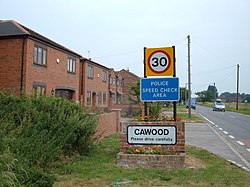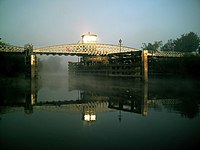Cawood
| Cawood | |
| Yorkshire West Riding | |
|---|---|
 Entering Cawood | |
| Location | |
| Grid reference: | SE572377 |
| Location: | 53°49’60"N, 1°7’54"W |
| Data | |
| Population: | 1,549 (2011) |
| Post town: | Selby |
| Postcode: | YO8 |
| Local Government | |
| Council: | North Yorkshire |
Cawood (sometimes written as Carwood) is a large village, and formerly a market town, in the West Riding of Yorkshire.
The village is notable as the finding-place of the Cawood sword, a mediæval sword pulled from the River Ouse here in the late 19th century. It most likely dates to the early 12th century, but has styling apparently derived from earlier Viking swords.
Cawood is south of the point where the River Wharfe flows into the River Ouse which subsequently forms the northern border of the village and the West Riding's border with the East Riding. Cawood Bridge is the only bridge from the village which spans the river.
According to Edmunds' "History in Names of Places" (London, 1869), the first syllable, Ca-, means a hollow, also a field. Edmunds gives Cawood of Yorkshire as an example. The last syllable -wood, is self-evident. The name, therefore, is a place-name of Anglo-Saxon origin and was first used to describe one who lived in a wooded hollow or field.
History and eritage
In his King's England series, Arthur Mee refers to Cawood as "the Windsor of the North". It used to be the residence of the Archbishops of York.
Cawood Bridge was opened in 1872: before then the only means of crossing was by use of a ferry. Dick Turpin is said to have forded the river when he escaped to York, which stands ten miles north of Cawood. The River Ouse used to flood the village regularly in winter. Since the floods of January 1982, whose height is marked on the bridgekeeper's cottage, river defences have been raised so that the fields on the northern side (Kelfield Ings) and the former Ferry Boat Inn, also on the Kelfield side, are now the only areas that flood, even at times of exceptionally high waters, such as in November 2000.
About the village
The houses and shops are located around the remains of Cawood Castle which lie at its centre. The castle was the residence of the Archbishops of York until the Reformation. It is possible to stay in the Castle Gatehouse, which is a Landmark Trust property.
Beside it is Castle Garth, a scheduled ancient monument, under which are the remains of the castle. It is currently owned by the village, but closely looked after by English Heritage and the local Garth group as a "green space" in the centre of the village.
The village has three remaining pubs: The Jolly Sailor on Market Place; The Ferry Inn beside the swing bridge over the River Ouse; The Castle Inn on Wistowgate.
In the 19th century there was a weekly market on Wednesdays, and a wide range of shops. During the 20th century, these gradually closed as village commercial life became dominated by the nearby market towns of Selby, Leeds and York. Today there is just a post office, a plant nursery, a hairdresser's and All Saints' Church.
There is an annual craft festival over August bank holiday weekend, in aid of the work of All Saints', where the villagers and local craft workers display their products at various venues throughout the village.
History
Cawood was formerly one of the chief places of residence of the Archbishop of York, who had here a magnificent Palace or Castle, in which several of the bishops died. It was obtained for the see of York from King Athelstan in the 10th century, by Archbishop Wulstan. The village surrounded its walls. Alexander Nevil, the 45th Archbishop, is said to have bestowed great cost on this palace, and to have adorned it with several new towers. Henry Bowett, the 49th Archbishop, built the great hall; and his successor, Cardinal Kempe, erected the gatehouse, the ruins of which are all that remain of this once magnificent building.[1]
In the 1800s Cawood was considered a market and parish-town, "in the wapentake of Barkston-Ash, liberties of St. Peter and Cawood, Wistow, and Otley; 5 miles from Selby, 7½ from Tadcaster, 10 from York, 12 from Pontefract, 186 from London."[1] Cawood being within the Liberty of Cawood, Wistow, and Otley made the village administratively independent from the justices of the West Riding.
Market was held each Wednesday. Fairs were held on Old May day and 23 September. The principal inn was named the Ferry House. The local church, a peculiar, was a vicarage, dedicated to All Saints, in the deanery of Ainsty (now New Ainsty). Notice of the union of the Liberty of Cawood, Wistow, and Otley with the West Riding of Yorkshire was published in the London Gazette on 21 March 1864.
One account has it that the children's nursery rhyme Humpty Dumpty refers to Cardinal Wolsey's 'great fall' at Cawood, when he was arrested by King Henry VIII's men.[2]
Outside links
| ("Wikimedia Commons" has material about Cawood) |
References
- ↑ 1.0 1.1 Information on Cawood from GENUKI
- ↑ "Village hails Humpty Dumpty". York Press. 13 August 1998. https://www.yorkpress.co.uk/news/7968151.village-hails-humpty-dumpty/. Retrieved 8 April 2020.


